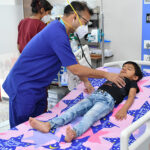
What is Radiology?
Radiology represents a branch of medicine that deals with radiant energy in the diagnosis and treatment of diseases. This field can be divided into two broad areas – diagnostic radiology and interventional radiology. A physician who specializes in radiology is called radiologist.
The outcome of an imaging study does not rely merely on the indication or the quality of its technical execution. Diagnostic radiology specialist represents the last link in the diagnostic chain, as they search for relevant image information to evaluate and finally support a sound diagnosis.
Radiology Techniques
Similar to the images produced in 1895, conventional radiographic images (usually shortened to X-rays) are produced by a combination of ionizing radiation (without added contrast materials such as barium or iodine) and light striking a photosensitive surface, which in turn produces a latent image that is subsequently processed.
The major advantages of conventional radiography are relative inexpensiveness of the images and the possibility to obtain them virtually anywhere by using mobile or portable machines (for example, mammography). Disadvantages are the limited range of densities it can demonstrate and the use of ionizing radiation.
Computed tomography (CT) currently represents the workhorse of radiology. Recent developments permit extremely fast volume scans that can generate two-dimensional slices in all possible orientations, as well as sophisticated three-dimensional reconstructions. Nevertheless, the radiation dose remains high, thus a very strict indication for every intended CT is needed.
Ultrasonography is still the cheapest and most harmless technology in radiology, which is the reason why many physicians outside radiology use this technique. Ultrasound probes utilize acoustic energy above the audible frequency of humans in order to produce images. As there is no ionizing radiation with this modality, it is particularly useful in imaging of children and pregnant women.
Magnetic resonance imaging (MRI) makes use of the potential energy stored in the body’s hydrogen atoms. Those atoms are manipulated by very strong magnetic fields and radiofrequency pulses to produce adequate amount of localizing and tissue-specific energy that will be used by highly sophisticated computer programs in order to generate two-dimensional and three-dimensional images. The major advantage is that no ionizing radiation is used.
Fluoroscopy represents a modality where X-rays are used in performing real-time visualization of the body, allowing for evaluation of body parts, administered contrast flow and positioning changes of bones and joints. Radiation doses in fluoroscopy are substantially higher when compared to conventional radiography, as many images are acquired for every minute of the procedure.
Nuclear medicine images are made by giving the patient a short-lived radioactive material, and then using gamma camera or positron emission scanner that records radiation emanating from the patient. Most common nuclear medicine modalities used in clinical practice are single-photon emission computed tomography (SPECT) and positron emission tomography (PET).
Finally, advances in equipment and increases in computer power have allowed combining data imaging sets from various modalities in radiology; the most popular use of this has been integration of PET functional nuclear medicine data with CT anatomic data (PET/CT), which currently has widespread use in the imaging of cancer.
Medical History
We provide the highest quality medical care, individualized treatment by the country’s leading experts, and in the shortest amount of time. Each patient is assigned a case manager to handle all medical issues.
There are many variations of passages of Lorem Ipsum available, but the majority have suffered alteration in some form, by injected humour, or randomised words which don’t look even slightly believable. If you are going to use a passage.
There are many variations of passages of Lorem Ipsum available, but the majority have suffered alteration in some form, by injected humour, or randomised words which don’t look even slightly believable. If you are going to use a passage. Lorem Ipsum available, but the majority have suffered alteration in some form, by injected humour, or randomised words which don’t look even slightly believable. If you are going to use a passage. If you are going to use a passage.
Experienced Physicians
There are many variations of passages of Lorem Ipsum available, but the majority have suffered
Personalized Treatment
There are many variations of passages of Lorem Ipsum available, but the majority have suffered
Quality and Safety
There are many variations of passages of Lorem Ipsum available, but the majority have suffered
Immediate Service
There are many variations of passages of Lorem Ipsum available, but the majority have suffered
Treatments
| Echocardiography | $250 |
| Implantable Cardiac Monitor | $230 |
| Treadmill stress testing | $575 |
| Transoesophageal | $320 |
| Pacemaker checks | $250 |
| Electrophysiology | $165 |
| Holter monitoring | $165 |
Lab Test
| Endoscopy | $250 |
| X-radiation | $230 |
| Cardiac CT scan | $575 |
| Blood Testing | $320 |
| Allergy Testing | $250 |
| Electrophysiology | $165 |
| Skin Testing | $165 |
Departments
Opening Hours
| Every Day | 24 hour's |
Doctors Availability
On the other hand we denounce with righteous indignation and denounce with men who are so.
Emergency Cases
On the other hand we denounce with righteous indignation and dislike men who are so.
+91 9116104308
Make an Appointment
On the other hand we denounce with righteous indignation.




